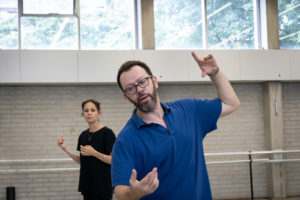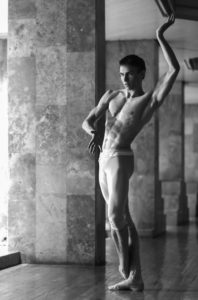United Ukrainian Ballet: Welcomed by the Netherlands and the world - Vancouver Ballet Society
- Home
- Features 2020 - 2023
- United Ukrainian Ballet: Welcomed by the Netherlands and the world

By Victor Swoboda
Displaced by war, 60 Ukrainian dancers, artists, and technicians have hastily joined a new company called United Ukrainian Ballet based in the Netherlands. “I read about the war every day, but I try to do it less often because I get too worried,” said one of the company’s ballerinas, Anastasia Mirraslavska, 26, speaking fluent English at the former Royal Conservatory building in The Hague. United Ukrainian Ballet (UUB) is rehearsing there in five large studios, with other rooms converted into sleeping quarters for many company members.

When Russian forces attacked Ukraine on February 24, Mirraslavska was asleep in her Kyiv apartment. A phone call wakened her. “My mother anxiously told me to look out the window. I saw Kyiv in a haze of smoke and heard terrible sounds.”
Born in Kharkiv, Mirraslavska moved to Kyiv to study ballet and theatre, returning home to dance at the Kharkiv National Theatre before returning to Kyiv to perform and teach ballet. Kyiv always seemed cheerful and lovely, but that February morning was different. “Hardly anyone was on the streets. It was all grey outside, with checkpoints here and there,” she said.
Six weeks into the war, like many thousands of compatriots, she decided to leave. “I didn’t want to leave. I love my country and city, but it became difficult to live. There were problems delivering food, prices went up, and there were no jobs.” Her decision greatly worried her parents. “But they understood I am young and need to continue my life, to try to build something and not just sit and wait until the war finished.”
Amid a long line of cars, she waited 20 hours to cross the border into Poland, then headed to Berlin before arriving in the Netherlands, where the Red Cross sent her to a Ukrainian refugee centre. “It was strange and a little scary, with rubber bunkbeds, a light on all night, and an outdoor shower. My bedmates from Mariupol had their home destroyed by missiles.”

Through a website, Mirraslavska found “a kind person who helped me find a home with a nice family — the kindest and most wonderful people I know.” The offer to join United Ukrainian Ballet came in June.
UUB makes a much-anticipated appearance at London’s Coliseum, September 13-17, in a new version of Giselle by Alexei Ratmansky, the eminent Russian-Ukrainian choreographer. All proceeds go to two non-profit foundations created in the Netherlands “to protect, support and spread Ukrainian culture.” Former Dutch National Ballet principal dancer Igone de Jongh initiated one of the foundations and helps to supervise UUB.
Mirraslavaska, who dances one of the Wilis in Giselle, says, “Ratmansky is so nice. He’s helped me to improve my skills. I like it here because the people are really professional.” Encouraged by the welcoming atmosphere, Mirraslavska acclimatized quickly.

“The worst for me is over,” declared UUB soloist Alexei Knyazkov, 29, speaking in Russian on a Zoom call just three days after arriving in The Hague at the end of July. UUB company manager Taras Onishchenko knew Knyazkov from previous artistic collaborations and invited him to The Hague. “Taras always has good projects. Plus UUB has some big names.”
Besides Ratmansky, these names include Ukrainian-born Katja Khaniukova, a first soloist with English National Ballet, and Alina Cojocaru, a former Royal Ballet principal who received early training in Kyiv. Each will dance the title role in Giselle as a guest artist.
With his broad grin, Knyazkov did not look like someone who had survived a war zone during the previous four months. Born in Kramatorsk, he danced major roles at the Kharkiv National Theatre. He was living one kilometre from the city centre when war erupted. “I saw the missiles aimed at the centre. Saltivka was razed to the ground,” he said, referring to the city’s largest residential area.

To show the world some of the horror occurring in Kharkiv, Knyazkov filmed a 25-minute YouTube video of himself walking among bombed-out buildings, along deserted downtown streets, and in front of boarded-up store fronts. To show hope, he filmed blooming flowers, green parks, and street musicians. The film ends with him crouched in a bomb shelter during an attack. “It’s hard to convey the emotions there,” he says. “You can watch videos from Ukraine but unless you were there, you won’t understand what’s going on.”
Mirraslavska said that UUB’s dancers do what they can to relieve their worries by trying to support each other, by smiling, telling jokes, and being helpful.
“We all more or less know each other,” said Knyazkov. “It’s a good environment here. We’re doing what we love. There are no bombs. I compare living in the conservatory to a sports complex. You come out of your room and there’s the ballet studio.”
Neither Knyazkov nor Mirraslavska ventured to predict their long-term future. Upcoming, in addition to Giselle, United Ukrainian Ballet will stage Swan Lake in Singapore, October 10-18, and in three Australian cities, October 20 to November 13.
“I really hope we celebrate Ukraine’s victory soon,” mused Knyazkov. “But you never know.”

